Take a Break from the News with Newsies

Photo courtesy of Chamblee OnStage
Newsies poster
This Thursday, months of work of more than one hundred students will culminate with the premier of Chamblee OnStage’s production of Newsies. The musical, which will have four performances from March 10 to 12, tells a story inspired by the real-life newsboys’ strike of 1899 in New York City.
Tickets for the show are for sale on the Chamblee OnStage website for $10 each at the following times:
- Thursday, March 10 at 7:00 p.m.
- Friday, March 11 at 7:00 p.m.
- Saturday, March 12 at 2:00 p.m.
- Saturday, March 12 at 7:00 p.m.
Why Newsies?
“We were looking at a few different options and Newsies presented the best challenge with the best opportunities for our cast to put on a really fun production. We hadn’t done a Disney production yet, and it features a lot of our strongest performers,” said Chamblee OnStage director Linda Lirette.
Newsies is a musical with a large amount of dancing, which the cast saw as a challenge they wanted to take on.
“This year we were looking for a show that was going to challenge us as far as dancing. This is a very dance-heavy show. It’s very high energy, very upbeat. The goal was to try to challenge ourselves with something that we knew we could do,” said senior cast member Jeremy Carlson (‘22).
The musical is based on the Disney film written by Bob Tzudiker and Noni White, and was originally produced on Broadway by Disney Theatrical Productions.
“Part of the appeal about Newsies is that it is a very popular and well-known show. A lot of our main people who are in the musical theater class knew the show very well before going into it,” said stage manager Kieran Mayer (‘22).
The Cast
With 45 students, the cast of Newsies is one of the larger productions that Chamblee OnStage has put on.
Carlson will be playing the male lead of the show, newsboy Jack Kelly.
“I’m playing Jack Kelly, which is the male lead. I’m the charismatic union leader for the Newsies and my job is to lead the Newsies through the strike and have some fun along the way,” said Carlson. “This is a new type of role for me. I’ve done lead roles before, but this is the first one where I actually have to play a serious character. So it’s been a challenge for me, but I think it’s been really fun because I’ve gotten to work with a lot of my close friends. […] We’ve been having a really good time getting to work on this show together.”
Carlson adds that coming back to the stage after the pandemic is a new experience.
“This year, it’s been interesting coming back to theater after being away from it for a whole year. Coming back to the theater with a lot of freshmen and sophomores that don’t have any experience under their belt has been interesting because this is a very dance heavy show and a lot of people don’t have any dance experience,” said Carlson. “It’s been a challenge, but it’s been a good challenge because I feel like we’re really pushing the program forward, especially because this is my last year at Chamblee.”
Junior Austin Wilson (‘23), who is playing the female lead of Katherine Plumber, names the people as her favorite part of working on the musical.
“I’m playing Katherine Plumber. […] She’s basically the female lead, love interest person,” said Wilson. “I think my favorite part has really just, this is so cliche, but just the people. Rehearsals are really annoying sometimes and everyone’s tired and grumpy and stressed, but what keeps you there is your friends and getting to meet all these new people and share a passion with them.”
The Crew
While not as visible to the audience as the cast, the crew of the show is responsible for everything happening behind the scenes. This year the crew consists of around 50 students.
“Crew is anyone that’s not pit or cast. Cast is the people acting on the stage and pit are the people playing their instruments. Crew is lighting. Crew is sound, set design, props, costumes, [and] more” said senior Olivia Mitchell (‘22), head of lighting.
The Pit
Made up of students on instruments including the trumpet, the clarinet, the slide whistle, and the electric violin, the show’s pit orchestra is responsible for the music part of the musical.
The musical’s pit is entirely student-led this year, featuring junior Nick Harrison (‘23) as the pit conductor and senior Julia Artigue (‘22) as the pit master.
“We play the music for when the cast sings, but we also play music otherwise. We have sound effects and we add the environment. We set up the scene and the ambiance,” said Artigue, who also plays the second keyboard in the pit and is the vocal assistant for the show.
The alternative to having a live pit orchestra for the show’s music is to have pre-recorded tracks.
“It works a lot better to have a live pit, because you could just use the tracks, but this way feels a lot more natural because the pit responds to what the cast is doing. There’s times where if lines are taking too long, we [can repeat the song] until the cast can go on so everything feels a lot more natural and it’s not staged and forced,” said Artigue.
Pit started out rehearsing separately from the cast, both later coming together to perfect the timing of the show.
“At the beginning, the pit, we rehearsed by ourselves and sometimes the cast would come in to work on a few things with us to make sure timing was correct, but then we would rehearse separately,” said Artigue. “As time went on, we started rehearsing together more to solidify timing and stuff. Now, since there’s only about a week left, we’re rehearsing together every day and we all know our music by now.”
Despite all of the work students have been putting into the production of the show, there have been some contretemps. Some students involved have complained about a lack of official understudies, which have been an element of past Chamblee OnStage musicals. Other complications have arisen from one of the main cast members leaving part way through production.
The Pandemic
Like almost everything over the past few years, Chamblee OnStage has been impacted by the COVID-19 pandemic throughout the rehearsal and production process.
“When we first started preparing, we were online. Our first two weeks of rehearsals were completely virtual due to the county being shut down for two weeks,” said Carlson.
Starting out virtually made it harder for the cast members to connect with each other, but they quickly got back to work once they returned in-person.
“It was virtual […], which was a bit awkward, to begin a musical in a virtual setting, because it was more difficult to connect with my fellow cast members,” said cast member Olivia Grove (’24). “That’s typically what the beginning of the rehearsal process is for, to build that camaraderie. We didn’t have so much of that this year, but once we started getting back into person, I think things started to fall more into place.”
Having to wear face masks has also affected rehearsals, especially for students who have singing parts.
“There’s just another layer of complexity that gets added to singing when you have a mask on, because a lot of the people in the show are singing a lot of really high notes, just due to the composition of the music. This is a lot more challenging when you’re not getting as much air as you normally would,” said Carlson.
Having to wear masks has an effect on not just singing, but also on sound and lighting.
“Because of the pandemic, we haven’t been able to be maskless on stage, which has been a challenge for the actors as well as of the tech, because the sound techs have to mic us when we have a mask on, which is a lot more challenging and the lighting techs have to find a way to light our face that isn’t going to make us look bad,” said Carlson.
Lirette points out that having to wear masks is a better option than students having extended absences because of illness or quarantining.
“We’ve had to make adjustments, but it really hasn’t had any major impacts beyond the ones that you would expect,” said Lirette. “[Having to wear masks] means that the microphones are harder to make sound good. We only see half of our cast’s faces so it’s harder to get a sense of their expressions. Vocally, the diction is less clear because of the masks, but if that has been keeping us healthy, that’s better because what’s worse is when you have extended absences due to quarantining or illness, because that really affects the rehearsal schedule.”
Why You Should Attend
With so many students involved in the production of Newsies, there’s a good chance you may know one of the people involved.
“Newsies is a super high energy, super fun uplifting show. The music is really, really good. There’s some good funny moments. You get to see all your friends participate. […] The crew has done such a good job this year and I have nothing but respect for them and all they’ve been putting into this,” said Carlson. “It’s definitely a show that, for how much time and energy we’ve put into it, is going to be worth it for anybody who comes to see it.”
Mayer adds that supporting the arts is important after hardships caused by the pandemic.
“I think that people should come and see Newsies. […] t’s a very good show that we’ve put an interesting take on and […] each version of a show that you’re going to see is different,” said Mayer. “Supporting the arts after COVID is very important because everybody took a hard hit from it.”
Lirette also ties the messages of Newsies to the COVID-19 pandemic with the ideas of essential workers and worker’s rights.
“It’s got a lot of great messages. The idea of people coming together to fight against injustice and to stand up for workers’ rights is a message that rings true. In the pandemic, we have recognized what it means to be an essential worker in new ways. And in 1899, the Newsies who delivered the news to all of the ‘important people’ in the cities weren’t seen as important until they made people understand that they were, that they were part of it,” said Lirette. “It’s a story about the little guys, it’s a story about collective bargaining, and it’s a story about the American way.”
Your donation will support the student journalists of Chamblee High School Blue & Gold. Your contribution will allow us to print editions of our work and cover our annual website hosting costs. Currently, we are working to fund a Halloween satire edition.

Keegan Brooks is a senior at Chamblee and this is his third year with The Blue & Gold. In five years, he hopes to be a student or alumni of a college somewhere. Hopefully by then he will have also finished the shows that he started watching, but never finished. He can be contacted via email at [email protected] or on Twitter @KeeganATL.











E. Avett • Mar 7, 2022 at 12:16 pm
Wish we could be in the audience!